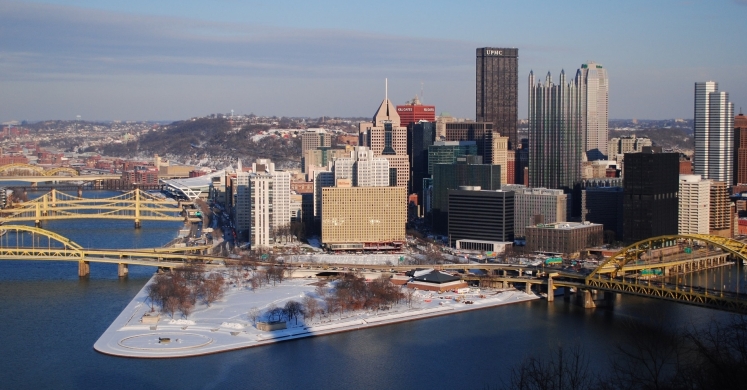Blog

#bioPGH Blog: A Winter’s Tale of Opposites: Urban Heat Islands
 A resource of Biophilia: Pittsburgh, #bioPGH is a weekly blog and social media series that aims to encourage both children and adults to reconnect with nature and enjoy what each of our distinctive seasons has to offer. From the best times to plant seasonal flora and enjoy their peak blooms, to astronomical events and creatures to keep an eye and ear out for, Phipps will keep you in the know with what’s going on in our environment!
A resource of Biophilia: Pittsburgh, #bioPGH is a weekly blog and social media series that aims to encourage both children and adults to reconnect with nature and enjoy what each of our distinctive seasons has to offer. From the best times to plant seasonal flora and enjoy their peak blooms, to astronomical events and creatures to keep an eye and ear out for, Phipps will keep you in the know with what’s going on in our environment!
Imagine a snowy morning here in Pittsburgh. Perhaps we shovel away some snow from our sidewalks or scrape the snow from our windshields before driving the morning commute. After all of that wintry work, what often seems to happen if we drive from a home in the suburbs or outskirts of downtown into the city? More often than not, it’s warmer, and there is less snow! Why is that? This strange phenomenon of warm cities is due to the urban heat island effect. What is that, you ask? Let’s explore!
The urban heat island effect occurs when temperatures in cities and downtown areas are higher, on average, than temperatures in the surrounding suburban and rural communities. Depending on the time of day and the size of the city, temperature differences can range from 2° to 22° degrees Fahrenheit between areas that are only miles apart. These higher temperatures are the result of the concrete and asphalt in modern cities absorbing sunlight and warming surfaces, plus all of the general activity from people, cars, buses, etc.
This heat island effect can be problematic for a number of reasons, particularly in the warmer months. Higher temperatures lead to increased costs and energy use as folks try to stave off the heat with increased air conditioning. Higher temperatures also reduce air quality as the heat speeds up the reactions of chemicals* around us, creating ozone and airborne particulate issues; poor air quality can become troublesome for those who work or live in the city, especially senior citizens or those with asthma, allergies, or heart problems. Heat islands can also lower water quality as warmed storm runoff water eventually enters waterways, disrupting natural life cycles of aquatic residents as fish, macroinvertebrates, and algae.
The good news is that Pittsburgh does actively combat urban heat, and you can help! Currently, the Department of Public Works is working with a variety of local non-profits and state agencies to create a forested city. Increasing the city’s tree canopy will help mitigate the effects of urban heat by increasing shade and helping to manage air and water quality. Also, Point State Park and its oasis of grass, trees, and shrubbery in the city are a great source of both heat and (bonus!) carbon management as the plants process carbon dioxide.
On a national level, the Environmental Protection Agency (EPA) has five strategies for citizens and businesses to help reduce urban heat. The first is planting trees and shrubbery, which is something all of us can do either at home or by volunteering with organizations like Friends of the Riverfront or the Western Pennsylvania Conservancy. The second suggestion is to build green roofs – like the one at Phipps’ Center for Sustainable Landscapes—because they provide year-round benefits by cooling in the summer and insulating in the winter. Win-win! If a green roof isn’t possible, the EPA’s third suggestion, cool roofs, might be. Cool roofs can top any building, and are a roof made out of heat-reflecting material rather than heat-absorbing. This ties in with the fourth suggestion of cool pavements for sidewalks and roads. In addition to managing heat, cool pavement has the added advantage of water permeability, which both reduces storm runoff and enhances road safety. The last EPA suggestion is all-encompassing and simply asks for smart growth: as we develop new areas and reshape existing communities, how can we design it to minimize heat islands? In the long run, it will save us expense, public health efforts, and energy.
Connecting to the Outdoors Tip: Pittsburgh has a number of green spaces within the city limits that can help deter the heat island effect. A great way to connect to the outdoors, especially if you work downtown, is a brisk lunch time walk to Point State Park. Besides a mental break, it can even help boost your health! Also, for a classroom or family activity that demonstrates how the heat island effect works, check out this activity from NASA’s Practical Uses of Math and Science page.
Continue the Conversation: Share your nature discoveries with our community by posting to Twitter and Instagram with hashtag #bioPGH, and R.S.V.P. to attend our next Biophilia: Pittsburgh meeting.
Resources:
Pennsylvania DCNR: Point State Park
Pittsburgh Department of Public Works: Forestry
Select photos: Wikimedia users Vaidor Otsar CC-BY-SA-3.0 and Asamudra CC-BY-3.0.

